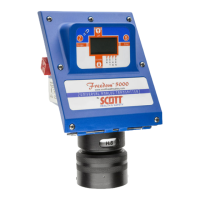42
087-0020 REV E
The following methods can be used during operational response checks of the
transmitter:
For GasPlus sensors detecting: Cl
2
, ClO
2
, O
3
, Br
2
, F
2
.
Place a teaspoon of powdered calcium hypo chlorite in a small plastic bottle and cap tightly.
When you wish to test a sensor, simply remove the cap and hold the mouth of the bottle near the
tip of the sensor.
For GasPlus sensors detecting: HCl
Observe Extreme Caution! Place about 10 cc of concentrated hydrochloric acid
(approximately 38% HCI) into a small plastic (polyethylene) bottle. Unscrew the cap and hold
the mouth of the bottle near the tip of the sensor.
For GasPlus sensors detecting: HF
Observe Extreme Caution! Line the bottom of a small plastic (polyethylene) bottle with 1 or 2
pieces of laboratory filter paper. Add 2-3 drops of concentrated hydrofluoric acid (49%) and cap
tightly. Unscrew the cap and hold the mouth of the bottle near the tip of the sensor.
For GasPlus sensors detecting: HCN, SO
2
, H
2
S
Observe Extreme Caution! Place about 10 cc of 1N sulfuric acid into a small plastic
(polyethylene) bottle. Add a few crystals of sodium sulfide to the acid just prior to testing the
sensor, since the resulting SO
2
gas will quickly dissipate. Hold the mouth of the bottle near the
tip of the sensor.
CAUTION: DO NOT CAP THE BOTTLE UNTIL THE GENERATION OF GAS HAS STOPPED,
OR THE BOTTLE MAY BURST.
For GasPlus sensors detecting: NH
3
Use household liquid ammonia. Hold the mouth of the bottle near the tip of the sensor. Do not
overexpose the sensor to ammonia or it will take a long time for it to recover to zero. Also, do
not splash liquid ammonia solution onto the membrane.
Freedom 5000 Universal Analog Toxic Gas Detector
Instruction Manual

